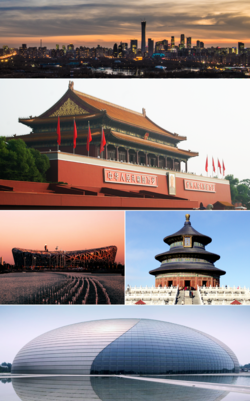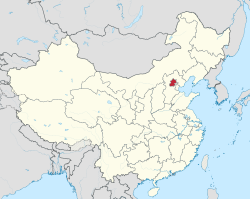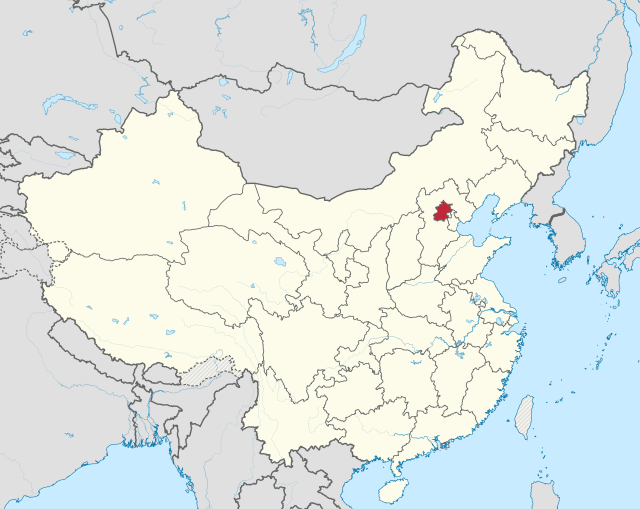Beijing
capital city of China From Wikipedia, the free encyclopedia
capital city of China From Wikipedia, the free encyclopedia
Beijing is the capital of the People's Republic of China. The city used to be known as Peking. It is in the northern and eastern parts of the country. Having more that 21 million residents, it is one of the most populous capital cities.
Beijing
北京市 Peking | |
|---|---|
 Clockwise from top: Beijing CBD skyline, Tiananmen, Temple of Heaven, National Center for the Performing Arts, and Beijing National Stadium | |
 | |
 Location of Beijing Municipality within China | |
| Coordinates: 39°55′N 116°23′E | |
| Country | People's Republic of China |
| Established | 1045 BC (Zhou Dynasty) |
| Divisions[1] – County-level – Township-level | 16 districts 289 towns and villages |
| Government | |
| • Type | Municipality |
| • Party Secretary | Cai Qi |
| • Mayor | Chen Jining |
| • Congress Chairman | Li Wei |
| • Conference Chairman | Ji Lin |
| Area | |
| • Municipality | 16,410.5 km2 (6,336.1 sq mi) |
| • Urban (2018)[3] | 4,144 km2 (1,600 sq mi) |
| • Rural | 12,266.5 km2 (4,736.1 sq mi) |
| Elevation | 43.5 m (142.7 ft) |
| Population (2018)[4] | |
| • Municipality | 21,542,000 |
| • Density | 1,300/km2 (3,400/sq mi) |
| • Urban (2018)[5] | 21,450,000 |
| • Metro (2017) | 24,000,000 |
| • Ranks in China | Population: 27th; Density: 4th |
| Major ethnic groups | |
| • Han | 95% |
| • Manchu | 2% |
| • Hui | 2% |
| • Mongol | 0.3% |
| • Other | 0.7% |
| Time zone | UTC+8 (CST) |
| Area code | 10 |
| ISO 3166 code | CN-BJ |
| GDP (nominal)[6] | 2018 |
| - Total | ¥3.03 trillion ($458 billion) (12th) |
| – Per capita | ¥140,748 ($21,261) (1st) |
| – Growth | |
| HDI (2017) | 0.888[7] (1st)—very high |
| License plate prefixes | 京A, C, E, F, H, J, K, L, M, N, P, Q, Y 京B (taxis) 京G (outside urban area) 京O, D (police and authorities) |
| Abbreviation | BJ / 京 (jīng) |
| City trees | Chinese arborvitae (Platycladus orientalis) |
| Pagoda tree (Sophora japonica) | |
| City flowers | China rose (Rosa chinensis) |
| Chrysanthemum (Chrysanthemum morifolium) | |
| Website | Beijing Official Website International – eBeijing.gov.cn (in English) 首都之窗-北京市政务门户网站 (in Chinese) |
| Beijing | |||||||||||||||||||||||||||||||||||||||||
 "Běijīng" in regular Chinese characters | |||||||||||||||||||||||||||||||||||||||||
| Chinese | 北京 | ||||||||||||||||||||||||||||||||||||||||
|---|---|---|---|---|---|---|---|---|---|---|---|---|---|---|---|---|---|---|---|---|---|---|---|---|---|---|---|---|---|---|---|---|---|---|---|---|---|---|---|---|---|
| Hanyu Pinyin | |||||||||||||||||||||||||||||||||||||||||
| Postal | Peking[8] Peiping (1368–1403; 1928–1937; 1945–1949) | ||||||||||||||||||||||||||||||||||||||||
| Literal meaning | "Northern Capital" | ||||||||||||||||||||||||||||||||||||||||
| |||||||||||||||||||||||||||||||||||||||||

The city of Beijing has played a very important role in the development of China. Many people from different cities and countries come to Beijing to look for better chances to find work. Nearly 15 million people live there. Beijing hosted the Summer Olympic Games in 2008, and the Winter Olympic Games in 2022. It is the only city that has hosted both.
Beijing is well known for its ancient history. Since the Jin Dynasty, Beijing has been the capital of several dynasties (especially the later ones), including the Yuan, Ming, and Qing. There are many places of historic interest in Beijing.
The Mandarin Chinese name of the city is Běijīng,[a] which means "The Northern Capital". It got this name when the Yongle Emperor of the Ming family of rulers moved most of his government from Nanjing ("The Southern Capital") in the early 1400s. In Chinese, Beijing's name is written Chinese: 北京. Today, people spell it "Beijing" because they use the pinyin way of spelling, which shows what the name should sound like in Mandarin. People used to spell it "Peking" because that was the spelling used by some of the first people from Europe to visit the Ming and write home about it; the Jesuits' work was made popular by their French brother Du Halde.[9] It then became the official Chinese Postal Map spelling around 1900 and continued to be used until pinyin became more popular.[10]
Beijing was also known as Beiping ("City of Northern Peace") between 1928 and 1949, when the Nationalists moved the Chinese capital to Nanjing and Chongqing.
The center of Beijing was settled in the 1st millennium BC. In those days, the Kingdom of Yan (燕, Yān) set up their capital where Beijing is today.[11] They called it Ji (蓟, Jì). After the Kingdom of Yan was destroyed, the city became smaller, although it was still an important place.
Beijing became more important again in the 10th century, when the Jin dynasty set its capital there. This city was destroyed by Mongol forces in 1215. Then in 1267, Mongols built a new city on the north side of the Jin capital, and called it "Great Capital" (大都, Dàdū), which was the beginning of modern Beijing. When Kublai Khan the Mongolian monarch, set up the Yuan dynasty, this city became his capital.
The Yuan Dynasty, Ming Dynasty and Qing dynasty all made Beijing their capital. When the Qing dynasty lost power and the Republic of China was set up, the new Republic moved its capital from Beijing to Nanjing. When the People's Republic of China seized power, Beijing became the capital of China again.
In 1989, there were protests in Tian'anmen Square because some people wanted democracy.[11]
Throughout its history, Beijing was the Chinese capital six times:[12]
Important places in Beijing include:
Beijing is the education center of People's Republic of China. More than 500 famous universities of China are in Beijing. They also include 5 of the top universities: Peking University, Tsinghua University, China People University, Beijing Normal University, and Beihang University. Beijing is also education center of China for teaching Chinese as a foreign language. The standard Chinese pronunciation is based on Beijing dialect, so over 70% foreigners who want to study Chinese go to Beijing for their studies.
Seamless Wikipedia browsing. On steroids.
Every time you click a link to Wikipedia, Wiktionary or Wikiquote in your browser's search results, it will show the modern Wikiwand interface.
Wikiwand extension is a five stars, simple, with minimum permission required to keep your browsing private, safe and transparent.